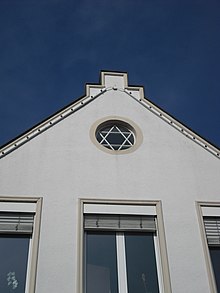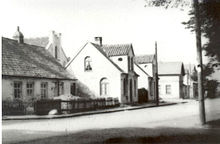Jever
The current term of office began on 1 November 2021 and ends on 31 October 2026 The full-time mayor Jan Edo Albers (Independent) is also entitled to vote in the city council.
On 22 November 2017, Lies was elected Lower Saxony's Minister for Environment, Energy, Building and Climate Protection.
For this reason, at the end of the 1960s, the town commissioned the former head of the Oldenburg State Archives and recognised expert in heraldry, Hermann Lübbing, to design a contemporary representation of the coat of arms on the basis of historical traditions.
They stand for "Donat Urbi Maria Gubernacula", meaning "Mary gives the power of government to the town" in Latin.
The 9th century epic Gudrunlied mentions the Danish dominion of Friesland and contains a reference to “Givers” in the area of Sande which is probably the first record of Jever.
A further reference in 1158 notes a town by the name of "Geverae", the latinisiation of the low German Geveren or Gaveren ("pasture", or alternatively "Place of the Thing").
Over time however land movements meant the access to the sea disappeared and the later construction of dikes has now left Jever well inland.
Today in the centre of Jever a children's playground with a climbing frame in the shape of a ship serves as a reminder of the city's important maritime past.
A letter sent to King Philip III of France, details that between 1271 and 1285, the people of Östringer were subject to no sovereign, but that they selected their own judges and chiefs themselves (see Frisian freedom).
After Prince Frederick August, who had supported the English in the American Revolutionary War for financial reasons, died in 1793, the male-line of Anhalt-Zerbst perished and its territories were split.
Jeverland was then inherited by Catherine II of Russia, formerly Princess Sophia of Anhalt-Zerbst and Frederick August's sole surviving sibling.
Because Anhalt-Zerbst had guaranteed security and freedom of business for Jews, Jever became a center of Jewish life in Frisia, reaching its peak in the late 19th century.
In the aforementioned historical apse is the listed Edo-Wiemken monument, which commemorates the last male East Frisian chief of the Jeverland and has already survived two fires in the course of history.
It was commissioned by Fräulein Maria, the daughter of Edo Wiemken, and was created between 1561 and 1564 by students of the Antwerp sculptor Cornelis Floris.
[17] It was built in 1610, but "again completely renovated and improved by Harmen Warner and Jakob Hanke, currently members of the Jever church jury" only fifty years later.
Its centre was a mighty Bergfried, which from the 16th century onwards was integrated into a four-wing castle complex surrounded by moats and ramparts.
Part of the façade is featured in the city's coat of arms with the inscription Donat Urbi Maria Gubernacula, meaning "Mary gives the town the power to govern".
Despite some demolitions (especially on St. Annenstrasse and Lindenbaumstrasse), and renovation measures on Hopfenzaun and Drostenstrasse, to which the Drostenhaus, among others, fell victim in 1975,[20] the old character of the inner city with its often plastered brick buildings has been largely preserved.
[25] A carillon at the "Hof von Oldenburg", inaugurated in April 1983, recalls the most important rulers of the Jeverland several times a day.
The carillon, made by the Korfhage tower clock factory in Melle, was donated by Jacobus Eden, who later became an honorary citizen of the town.
It is one of the few places in Germany where the traditional craft of old East Frisian and North German Blaudrucks (blue printing) is still practiced.
The brewery's mirrored fermentation towers on the banks of the Elisabeth River contain five tanks of 240,000 litres each, in which the young beer is stored at -1 °C for three to four weeks before bottling.
The Historical Brewery Museum attached to the Friesisches Brauhaus shows how beer was brewed a good hundred years ago.
A tour of today's modern brewery under the guidance of an expert will show you how time-consuming and labour-intensive it was to produce a few bottles of beer.
In addition to well-known European hardwoods (e.g. beech, oak, lime), the castle park also offers exotic woods.
Jever is the venue of the Landesbühne Niedersachsen Nord (LBNN), which presents about ten productions in the city throughout the year.
The Artists' Forum has at its disposal the listed building ensemble of a former engine shed and signal box at Moorweg 2 in Jever, from which the association created a venue for cultural presentations of all kinds.
This festival, which is celebrated peripherally in the various well districts, goes back to a Jeverian well decree, which was issued by the Jever municipal authorities under Prince Friedrich August of Anhalt-Zerbst (1734-1793) on 9 October 1756.
[40] The Altstadtfest, which has been held on weekends in the first half of August since 1974, presents the town's rich club life in addition to many stalls, events and live music.
A Christmas market, which opens its doors in the week before the first Advent, brings the great annual festivities of Jever to a close.















